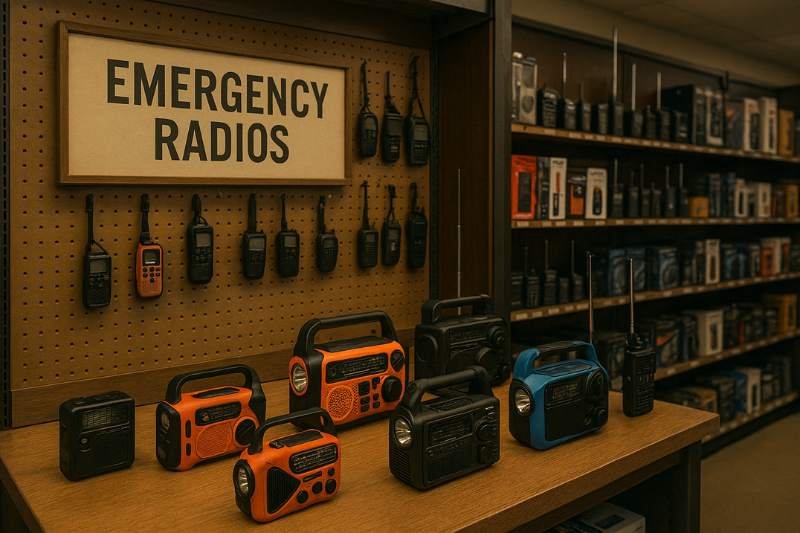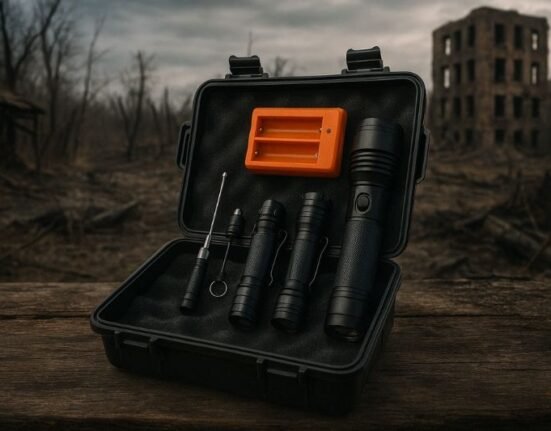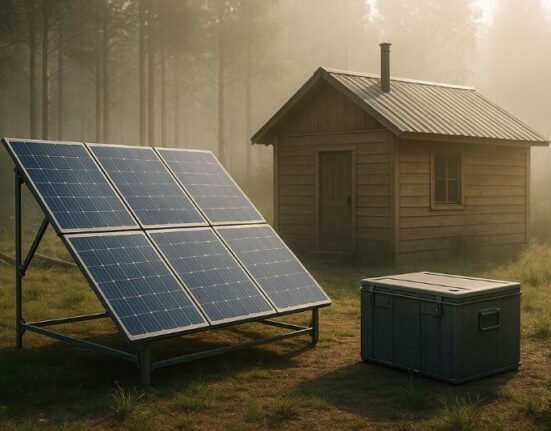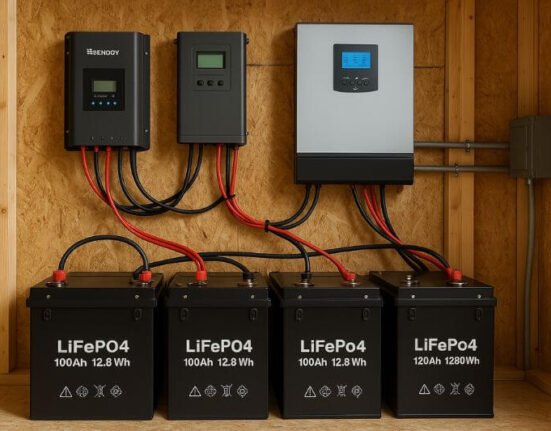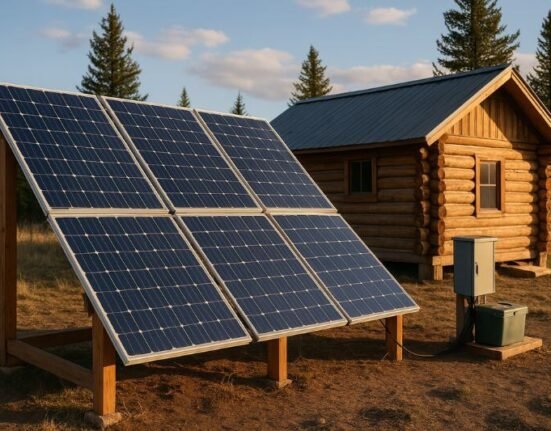In this emergency radios guide, you’ll discover why analog communication tools remain one of the most important pieces of survival gear—even in our hyper-connected digital world.
When disaster strikes, the first systems to collapse are often digital: cell towers, Wi-Fi, GPS, and internet servers. Yet access to timely, reliable, and location-specific information can determine whether you live or die. Emergency radios don’t just offer that access—they restore control in the middle of chaos.
Whether you’re facing a hurricane, blackout, forest fire, or civil unrest, a well-chosen emergency radio can:
- Provide NOAA weather alerts in real time
- Broadcast government and rescue agency warnings
- Connect you to AM/FM updates when the grid goes down
- Charge your phone or flashlight when other power sources fail
- Help you signal for help using built-in SOS features
And the best part? Many of these devices work without internet or external power, making them reliable even during long-term crises.
This guide walks you through the key features to look for, the different types of emergency radios, and how to choose the best model for your survival context—urban, rural, mobile, or off-grid.
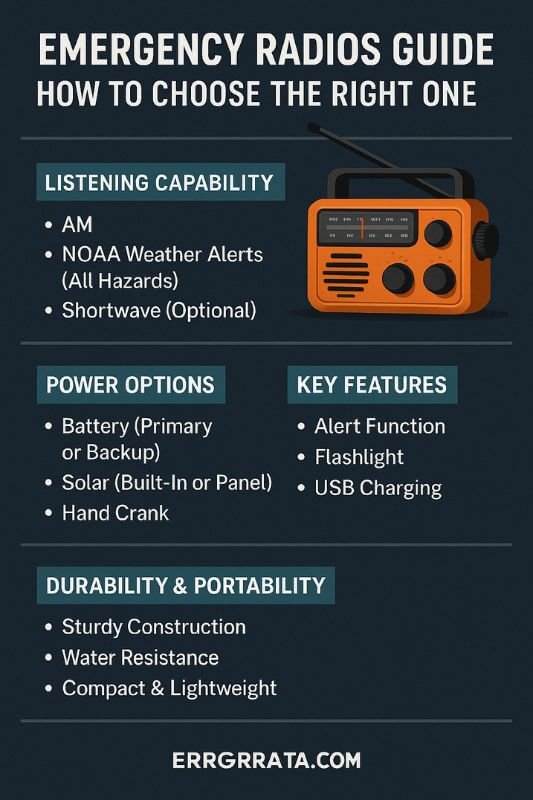
🟦 Why Emergency Radios Still Matter in the Digital Age
🧠 When the Grid Goes Down, Radio Still Works
In a connected society, it’s easy to assume that information will always be a tap away. But as recent disasters have shown, the moment electricity or cell service fails, your smartphone becomes a flashlight at best.
Emergency radios are designed for one purpose: to keep broadcasting when everything else fails. They don’t rely on external networks. They don’t need stable power lines. And they work with basic components and redundant systems—crank power, solar panels, or internal batteries.
✅ In a world full of smart devices, sometimes dumb is smarter.
🌪️ Real-World Scenarios Where Radios Saved Lives
- Hurricane Katrina (2005): AM/FM and NOAA radios were the only way for many stranded citizens to receive emergency instructions when mobile towers collapsed.
- Japan Earthquake & Tsunami (2011): When the grid went down, battery-powered and crank radios helped families stay connected to shelter info and radiation warnings.
- Texas Blackout (2021): Emergency radios helped residents in freezing homes get rolling blackout schedules, warming center locations, and alerts about carbon monoxide risks.
- Ukraine War (2022): Civilians in bombed areas turned to shortwave radios for news, as internet and mobile coverage were taken offline.
Whether you live in a major city or off-grid, radio is the last line of information survival when digital fails.
Key Features to Look For in an Emergency Radio
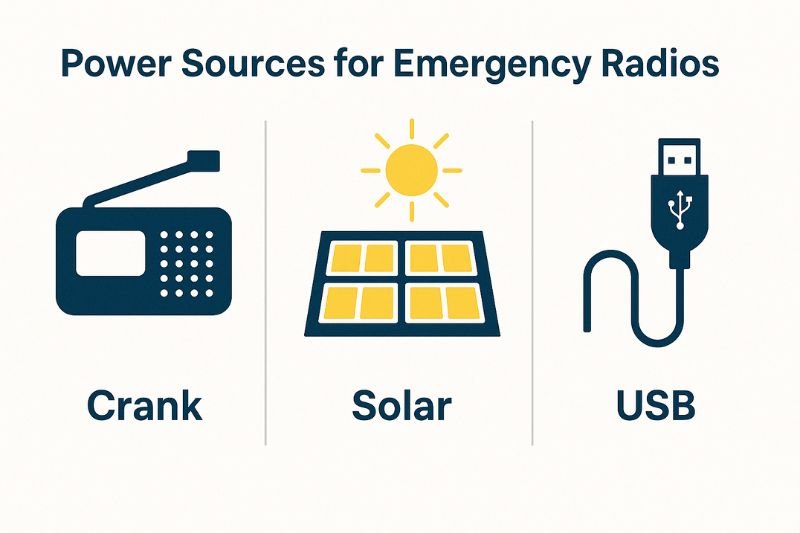
When shopping for a survival radio, it’s easy to get overwhelmed by flashy features or generic specs. But in a real emergency, you need a radio that’s rugged, reliable, and purpose-built to keep you informed when everything else goes dark.
This section of the emergency radios guide breaks down the must-have functions to look for, so you don’t end up with a toy when what you need is a tool.
🔋 Power Sources: Crank, Solar, Battery, USB
A dead radio is dead weight. Choose models with multiple power options, including:
- Hand crank – Generates power manually; ideal for blackouts or remote zones
- Solar panel – Recharges the radio slowly in daylight (best as backup)
- Rechargeable battery (Li-ion) – Can be charged by USB or wall outlet
- Standard batteries (AA/AAA) – Easily replaceable in the field
- USB power bank output – Some radios can charge your phone or flashlight
✅ Pro tip: Look for radios that can charge while operating, so you don’t lose access during a storm or bug-out.
📡 Alert Types: NOAA, AM/FM, Shortwave, S.A.M.E
The information channels your radio receives are just as important as how it’s powered.
- NOAA Weather Alerts – Real-time official updates from the National Oceanic and Atmospheric Administration (US only, but many radios support it)
- AM/FM – Covers local news, emergency broadcasts, and civil defense alerts
- Shortwave – Receive global signals from beyond your region (especially useful in warzones or international crises)
- S.A.M.E. (Specific Area Message Encoding) – Region-specific alerts; the radio will sound an alarm only for your local area
✅ Best practice: Choose a radio with auto-scan + alert activation to detect signals while you rest or sleep.
🛠️ Durability, Portability, and Runtime
A survival radio must survive more than just shelves.
Look for:
- Shock-resistant housing
- Water-resistance or waterproof rating (IPX4 minimum)
- Compact design for packability
- Rubberized knobs/buttons for use with gloves
- Battery life > 10 hours on low volume or standby
- Antenna that retracts or folds without snapping
✅ Many radios break under stress. Test yours by dropping it from waist height onto concrete—it should keep working.
🎁 Bonus Features Worth Having
These aren’t essential, but they add massive value in field conditions:
- Flashlight or LED lamp – Great for signaling or navigating dark rooms
- SOS Alarm Beacon – Emits a loud siren and/or flashing light to alert rescuers
- Digital display with backlight – Easier to tune accurately at night
- Headphone jack – Allows for silent monitoring during stealth scenarios
- Speaker quality – Look for clear, non-muffled audio even at low volume
✅ Some higher-end models combine radio + light + charger into one multi-use survival device—ideal for minimalist bug-out setups.
🧠 Final Tip:
Don’t be fooled by pretty displays. A true emergency radio is functional, field-tested, and reliable when soaked, dropped, or cranked a hundred times. Always test it before you need it.
Choosing the Best Emergency Radio for Your Needs
There’s no such thing as a one-size-fits-all solution when it comes to survival gear—and emergency radios are no exception. The best model for your situation depends on where you live, how mobile you are, and who you’re preparing for.
Let’s break it down.
🏙️ Urban vs. Rural Use
Urban environments often suffer from infrastructure overload—power outages, tower collapse, and building signal interference. You need:
- Compact, multi-band radios with good signal penetration
- NOAA/SAME compatibility for local alerts
- Rechargeable batteries + hand crank for grid-down situations
Rural or off-grid areas are more vulnerable to:
- Extreme weather, isolation, and lack of cellular coverage
- Shortwave capability can be useful to catch regional or global transmissions
- Solar + battery hybrid power is often ideal when sunlight is available
✅ Choose your radio like you’d choose your shelter: based on your geography.
👨👩👧👦 Solo vs. Family Preparedness
If you’re prepping alone:
- Go light: a compact, crank-powered model with built-in flashlight
- Prioritize portability and stealth over bells and whistles
- Rechargeable via USB to pair with a solar bank
If you’re prepping for a family or group:
- Look for radios with loud, clear audio
- Include visual alert modes (like flashing lights) for the hearing impaired
- Keep multiple power sources (AA batteries + crank + USB)
- Consider having a backup unit in a secondary bag
✅ Redundancy is safety. If it’s critical gear—carry two.
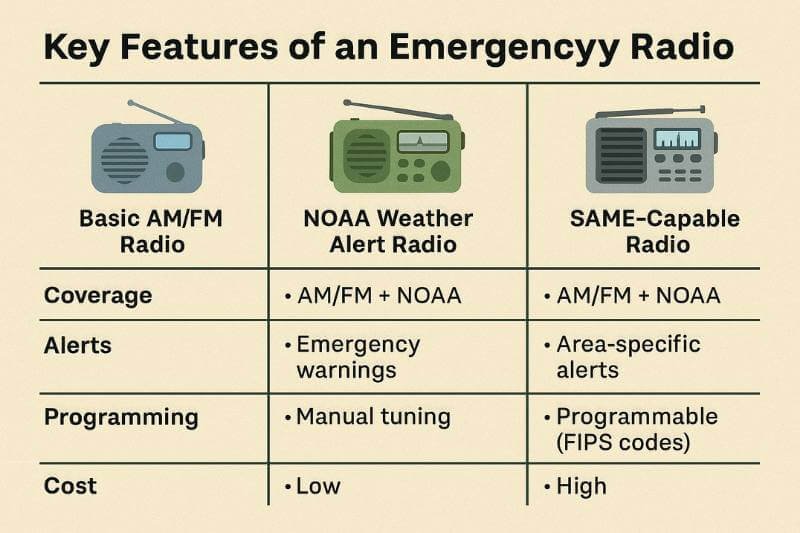
🏆 Top Picks by Category
| Category | Recommended Feature Set | Why It Works |
|---|---|---|
| Budget Option | AM/FM + NOAA + crank/USB + flashlight | Good for beginners or backup use |
| Compact EDC | Ultra-light, USB-charged, AM/FM only | For urban survivalists and mobile kits |
| Heavy-Duty Prepper | Shortwave + NOAA + solar/crank/USB + flashlight + SOS beacon | Best all-in-one tool for long-term use |
| Off-Grid Base | Large battery, solar panel, shortwave, rechargeable + dry cell option | Perfect for shelters, cabins, or homesteads |
✅ Brand examples (non-affiliated):
- Midland ER310 – Great all-rounder
- Kaito KA500 – Shortwave + solar/crank hybrid
- Eton Sidekick – Rugged, USB-friendly, NOAA + Bluetooth
🔧 Maintenance and Long-Term Storage Tips
Even the best radio won’t help you if it’s dead or corroded when you need it. Maintain it like a life-saving device:
- Charge and test monthly
- Keep batteries out during long storage to prevent leaks
- Store in a padded, waterproof pouch inside your go-bag
- Practice tuning quickly to key frequencies (preset labels help)
- Keep a laminated frequency cheat sheet taped to the back
✅ Pro tip: Mark important local stations and NOAA codes directly on your radio or pouch for fast access.
🧠 Final Word
You can’t control when the next disaster strikes. But with the right emergency radio, you can control how well you respond to it—informed, connected, and one step ahead.
❓ Frequently Asked Questions (FAQ) – Emergency Radios Guide
📡 Do emergency radios work without internet or cell service?
Absolutely. That’s exactly what they’re designed for. Emergency radios use analog airwaves (AM/FM, NOAA, or shortwave), which are broadcast via radio towers or satellites—not dependent on the internet or telecom networks.
This means that even if:
- Cell towers are down
- Wi-Fi is unavailable
- Power grids have failed
…you can still receive critical updates, weather alerts, and rescue communications.
✅ In fact, in most large-scale disasters, emergency radio is the only functional channel left. That’s why agencies like FEMA and the Red Cross recommend them in all go-bags.
🌩️ What’s the difference between NOAA and AM/FM alerts?
Great question. While AM/FM covers general radio content (like local news, music, and talk shows), NOAA radio is specifically built for continuous emergency broadcasts.
| Type | Source | Purpose |
|---|---|---|
| AM/FM | Civilian broadcasters | News, entertainment, updates |
| NOAA | National Oceanic & Atmospheric | Weather alerts, evacuation notices |
✅ NOAA uses 7 frequencies dedicated to weather and emergency info across the U.S. Many emergency radios can scan these automatically and sound an alarm if something serious happens (like a tornado warning or chemical spill nearby).
🔋 How long can a hand crank radio last during a blackout?
It depends on the brand and power storage, but here’s a realistic range:
- 1 minute of cranking = ~10–20 minutes of listening time
- Solar charging can take 6–10 hours for a full battery
- USB recharging often takes 2–4 hours
On average, a fully charged emergency radio (via crank or USB) can:
- Broadcast audio for 8–12 hours
- Power a flashlight for 6–10 hours
- Charge a phone partially (20–40%) via USB
✅ Pro Tip: Crank regularly in short bursts to maintain charge without exhausting yourself—and always keep a solar panel or extra batteries as backup.
🚨 Can one emergency radio cover all survival needs?
It depends on your survival context. For most individuals, a high-quality emergency radio can cover:
- Information access (NOAA, AM/FM, shortwave)
- Lighting (built-in flashlight or reading lamp)
- Signaling (SOS siren or strobe)
- Charging (USB port for phones or flashlights)
However, for family preparedness or long-term off-grid survival, it’s often smart to have:
- A compact EDC model for bug-outs
- A larger, multi-function model for shelter-in-place scenarios
- Extra charging options (solar panels, power banks)
✅ Redundancy = resilience. A $40 backup unit could save your life if your primary gear fails or gets damaged.









